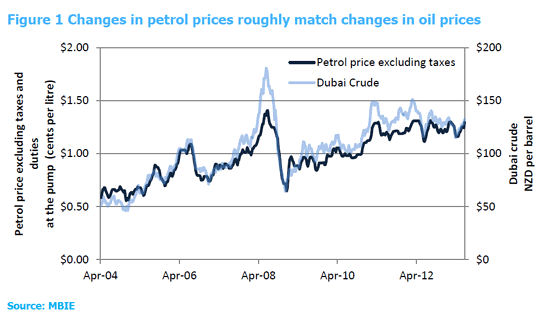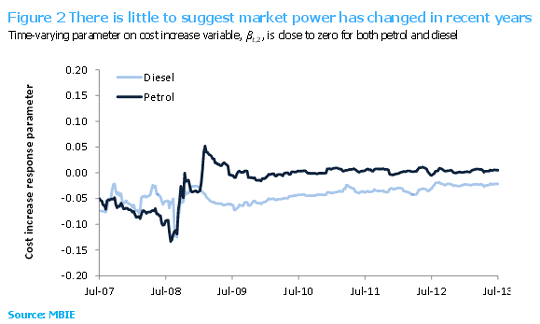By Kirdan Lees*
Often motorists complain that petrol companies are quick to raise petrol prices at the pump but then conspire to drop prices slowly when international oil prices fall.
Like in any efficient market, changes in the cost of oil - both up and down - should be passed on to consumers rapidly.
We run the numbers and find no evidence of opportunistic gouging. Petrol companies pass on oil price decreases to consumers just as quickly as they pass on increases in prices.
The good oil on petrol prices
The price of petrol is mostly made up of taxes and levies that retailers can do little about.1
Figure 1 shows that, without these taxes, levies and the cost of the Emission Trading Scheme, weekly petrol prices roughly match weekly movements in the New Zealand dollar price of Dubai crude (using data from April 2004 to June 2013, available from the Ministry of Business, Innovation and Employment (MBIE)).2

At first glance, it appears that changes in oil prices are passed through to petrol prices relatively quickly. But whether the price response to increases in costs is the same price response as decreases in costs (the New Zealand price of Dubai crude) is not immediately obvious. Fuel prices could well be sticky downwards.
Some argue that when the cost of Dubai crude falls the old price offers a natural focal point for oligopolistic sellers who wish to preserve margins (see Borenstein et al. (1997), for example).
In many other countries, there are concerns that domestic petrol retailers have enough market power so that increases in costs are passed on more quickly than falling costs (see for example Australia, Canada, the United Kingdom and the United States).3
So we need to dig deeper to uncover whether New Zealand companies have market power over the retail price of petrol.
Running the ruler over pump prices
Our test for whether consumers pay too much at the pump looks at whether cost rises are passed on as quickly as cost falls. We take the percentage change in the Dubai oil price data in Figure 1 and construct a cost increase variable, that takes the change in price for all price increases but is 0 when the price falls.
That is:
If cost increases drive more rapid increases in prices at the pump, then our variable should help explain movements in petrol prices above and beyond changes in oil prices.4 That makes our regression for market power:
We also add lags of the variables as appropriate to our market power regression. Table 1 below shows our results for both petrol and diesel there is no evidence of price gouging in this way. Our cost increase variable is unimportant in explaining price movements at the pump
cost increases have similar impacts to price decreases.

Are market dynamics improving over time?
We can expand our market power test to see if the degree of market power is changing over time. If market power is increasing over time, we expect oil price increases to lead to higher and longer increases at the pump relative to price decreases. To test for changing market power, we allow the parameter on our cost increase variable regressions to change or vary over time. This same test for changes in market power could be used more broadly in other markets.
Figure 2 shows the parameter on the relative responsiveness to cost increases has not changed much over recent history. So there is little to suggest changes in market power for either petrol or diesel.
1) The last 3c - a - litre increase in excise tax means the price of petrol is about 60 percent taxes and 40 percent determined by the cost of importing fuel.
2) See the weekly price monitoring information here: http://www.med.govt.nz/sectors - industries/energy/liquid - fuel - market/weekly - oil - price - monitoring.
3) See Bacon (1991), Deltas (2008), Noel (2009), Valadkhani (2010), Bermingham and O'Brien (2011), Clerides (2010), NZIER (2011) and Douglas (2010).
4) See Douglas (2010) and Valadkhani (2010) who use a very similar methodology.
*Dr. Kirdan Lees is a senior economist and head of public good research at the New Zealand Institute of Economic Research.
-------------------------------------------------------------------------------------------------------------------------------------------------------------------------------------------
5 Comments
If a doubling of the importer margin on petrol in the past four years isn't ample evidence of market power and gouging, then there's no evidence of rainfall in Auckland.
(Importer margin on petrol in 2010: 6%. Importer margin on petrol 2013: 12%).
With 5 or so compeditors this should not be happening, so one has to suspect collusion. Bet our useless authorities would not agree or lift a finger to enforce a compedative market, in common with their behaviour in a lot of other market sectors.
If they were making say 5cents and are now making 10cents Gross (ie before costs), then some or most of that could be down to their costs rising yet they are selling no more (and apparantly less) petrol to spread that increased overhead on.
regards
I think it is great that this includes the working and cites the sources, but I don't particularly agree with the conclusions. If I take the same data the best regession with Dubai crude is the petrol prices of the following week (Adjusted R-squared: 0.8969). However, if I construct a up/down variable for Dubai crude (based on the preceding week's price), and do an anova comparison of the residuals (the unexplained component) between weeks of rising prices (Up) and weeks of falling prices (Down), the result is that the difference in the residuals is only 1.34% likely to occur by chance. This suggests that the way in which up events are responded to by petrol companies, when compared to the way price drops are responded to, should be investigated further (rather than just focusing on price rises).
Essential products like fuel should always be monitored for their pricing power. This study is fine, but there are other questions re pricing mechanisms that seem worth asking. Whether oil companies are quicker up than down is somewhat important, but probably more relevant, is whether they have rounded up the difference in some way over time. The increase in importer margins from 6 to 12% that Yoda above points out suggests they have. Even more important is whether 12% is fair or not. Is it the gross margin, out of which they have to pay all management, marketing, storage and distribution costs? Does it include the retail margin, which then has to include all the petrol station costs? If it is either or both of of these, 12% doesn't seem all that massive to me. Just maybe 6% was artificially low due perhaps to excess refinery capacity in the region of at least one of the companies, where that company was looking to sell through as much product at almost any margin as possible. Just maybe that was one reason Shell sold out. Most majors would look at the combined refinery plus importer plus retail margin.
Has the study allowed for the increase in supermarket linked discounts, such that anyone using those will likely be paying at least 4 cents to say 25cents a litre less than the pump price.
I would note that a move from 6% to 12% does not need collusion in any organised sense. It just needs none of the companies to aggressively chase market share based on price.
Am happy enough to disclose that I worked for one of the major oil companies from the early 80s to the mid 90s.
We welcome your comments below. If you are not already registered, please register to comment
Remember we welcome robust, respectful and insightful debate. We don't welcome abusive or defamatory comments and will de-register those repeatedly making such comments. Our current comment policy is here.